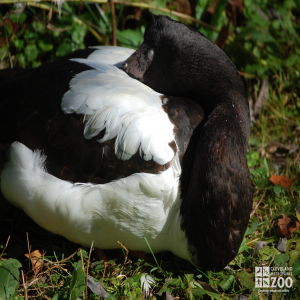Magpie Goose
[Anseranas semipalmata]

The Magpie Goose male averages 29.5 to 35 inches in length, with a wingspan of 51 to 71 inches, and a weight of about 6 pounds. Females average 27.5 to 31 inches in length, with a wingspan of 49 to 65 inches, and a weight of about 4.4 pounds. There is a protuberance on top of the head which is variable in size, but is smaller in females. The head and neck are black, as is the tail. The upper tail coverts and most of the upper wing coverts are white. Juveniles are grayer and more mottled. Feet and legs are yellow.
Location: Animals Formerly at Zoo
Share:
Range
The range of the Magpie Goose is New Guinea and northern Australia.
Habitat
The Magpie Goose inhabits swamps and grasslands in floodplains of tropical rivers and are usually found not far from coasts.
Conservation Status
Least ConcernPrimary Threats
Gestation
Incubation: 23 to 25 days
Litter
Clutch: 1 to 16; usually 5 to 11
Behavior
Magpie Geese are not truly migratory but wander extensively in relation to food and water availability. They are occasionally reported outside their normal range throughout much of Australia and even Tasmania, especially during the dry season.
Reproduction
Magpie Geese are often polygamous, typically one male paired with two females. Breeding starts at the beginning of the wet season. They form fairly large colonies. The nest is a large floating mound of vegetation. Chicks have gray down, whiter below, with cinnamon head and neck. Fledging is at about 11 weeks. Sexual maturity is at 2 years in females, and 3 to 4 years in males. Breeding success can be markedly reduced by severe dry seasons and by predators. Nests are often destroyed by predators.
Wild Diet
Grass, seeds, bulbs, rhizomes
Zoo Diet
Waterfowl diet
